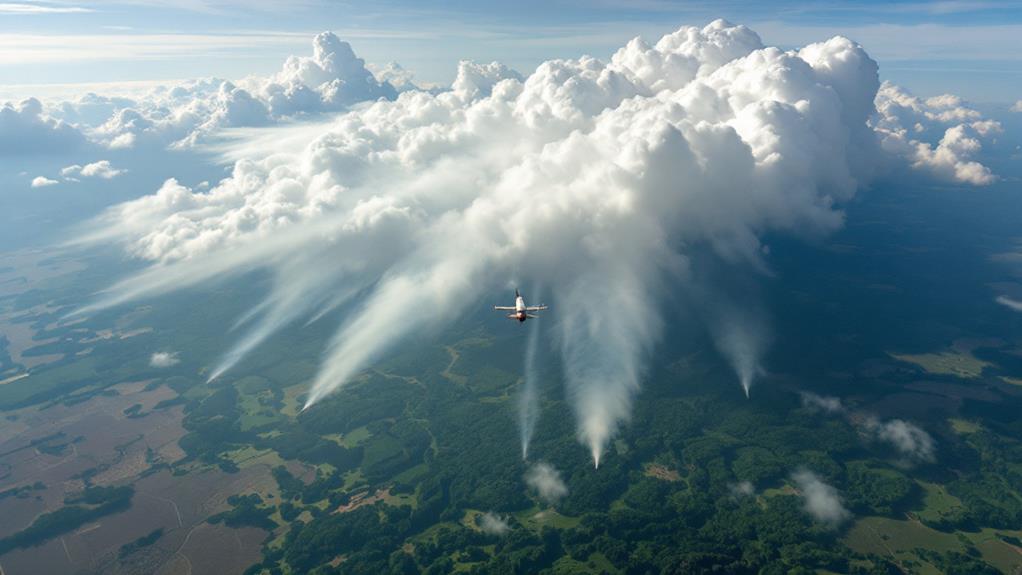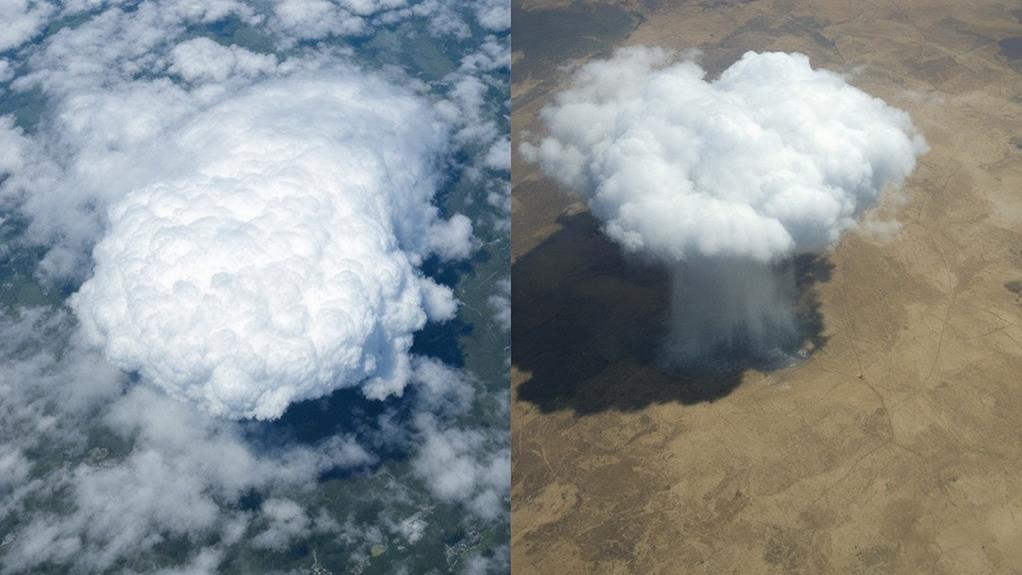Is It Possible to "Seed" Clouds to Increase Rain Intensity or Change Their Trajectory?

Yes, it's possible to "seed" clouds to increase rain intensity and potentially influence their path. Cloud seeding involves dispersing particles like silver iodide into clouds to enhance precipitation. This technique can increase rainfall by up to 10% under favorable conditions. However, its effectiveness depends on various factors, including cloud type, temperature, and atmospheric conditions. While cloud seeding can't create rain from thin air, it can accelerate the natural process of water droplet formation. The science behind this weather modification method is complex, and its long-term impacts on the environment and climate patterns are still being studied. There's much more to uncover about this fascinating technology.
Cloud Seeding Basics
How exactly does cloud seeding work? It's a weather modification technique that aims to enhance precipitation by introducing substances into clouds. You'll find that cloud seeding typically involves dispersing particles like silver iodide or dry ice into the atmosphere. These particles act as nuclei around which water droplets can form and grow.
To understand cloud seeding, you need to grasp cloud formation dynamics. Clouds develop when water vapor condenses around tiny particles in the air. By adding more of these particles, cloud seeding attempts to accelerate this process. The goal is to increase the likelihood of precipitation or alter the size of water droplets within the cloud. Cloud seeding is used to increase rainfall or snowfall in a region, which can provide benefits such as enhancing water supply and preventing drought.
Atmospheric moisture patterns play an essential role in cloud seeding's effectiveness. You'll see better results in areas with existing moisture but insufficient natural nuclei for droplet formation. Cloud seeders must carefully time their operations and target specific cloud types to maximize impact. They often focus on supercooled clouds, where water remains liquid below freezing temperatures. By introducing nuclei, they aim to trigger the ice crystal formation process, potentially leading to increased rainfall or snowfall.
Historical Development
Tracing the roots of cloud seeding takes us back to the mid-20th century. In 1946, American chemist Vincent Schaefer investigated that dry ice could create ice crystals in supercooled clouds. This breakthrough led to the first successful cloud seeding experiment in 1947, conducted by Schaefer and Irving Langmuir. Benjamin Franklin's invention in 1753 demonstrated the electrical nature of lightning, which later influenced the development of cloud seeding techniques.
As the world grappled with climate variability, interest in weather modification grew rapidly. In the 1950s and 1960s, numerous countries launched cloud seeding programs to combat drought and increase precipitation. The United States, Soviet Union, and China were at the forefront of these efforts.
Over the decades, scientists have refined cloud seeding techniques and developed new materials, such as silver iodide, to enhance the process. Despite advances, the effectiveness of cloud seeding remains a subject of debate. You'll find that while some studies report positive results, others question the method's reliability and long-term impacts.
Today, cloud seeding continues to be examined as a potential tool to address water scarcity and mitigate the effects of climate change. However, you should be aware that its use remains controversial, with ongoing research seeking to better understand its efficacy and environmental consequences.
Scientific Principles Behind Cloud Seeding

Cloud seeding relies on fundamental principles of atmospheric physics and chemistry. The process involves introducing particles into clouds to stimulate precipitation. These particles, typically silver iodide or dry ice, act as nuclei around which water vapor can condense.
You'll find that cloud seeding works by enhancing the natural processes of moisture absorption and droplet formation. When conditions are right, the introduced particles attract water molecules, causing them to grow and eventually fall as rain or snow. The effectiveness of cloud seeding depends on various atmospheric conditions, including temperature, humidity, and wind patterns.
It's important to understand that cloud seeding can't create rain from thin air. Instead, it aims to increase the efficiency of existing cloud systems. The process works best when there's already moisture present in the atmosphere. Seeding can trigger precipitation in supercooled clouds, where water remains liquid below freezing temperatures.
Scientists continue to study and refine cloud seeding techniques, focusing on optimizing particle distribution and timing. While the basic principles are well-established, the intricacies of weather systems make predicting and controlling outcomes challenging.
Cloud Seeding Techniques
Several cloud seeding techniques have been developed and refined over the years. You'll find that these methods aim to enhance cloud formation processes and manipulate atmospheric stability factors to increase precipitation. The most common technique involves dispersing silver iodide particles into clouds using aircraft or ground-based generators. These particles act as nuclei for ice crystal formation, promoting rainfall.
Another approach you might encounter is hygroscopic seeding, which uses salt-based materials to accelerate the coalescence of water droplets. This method is particularly effective in warm clouds where ice formation isn't necessary for precipitation.
You'll also come across the use of liquid propane in cold cloud seeding. When released into supercooled clouds, propane rapidly expands and cools, creating ice crystals that can trigger snowfall.
More advanced techniques involve using electrical charges to influence cloud behavior. By releasing charged particles into the atmosphere, you can potentially alter the electrical properties of clouds and enhance precipitation.
Each of these methods requires a thorough understanding of local weather patterns and careful timing to maximize effectiveness and minimize potential environmental impacts.
Effectiveness and Limitations

The effectiveness of cloud seeding remains a topic of debate among scientists and meteorologists. While some studies suggest it can increase precipitation by up to 10%, others argue that the results are inconclusive. You'll find that the success of cloud seeding operations depends on various factors, including cloud type, temperature, and atmospheric conditions.
One of the main limitations you'll encounter is the dispersal of seeding agents. It's challenging to guarantee that the particles reach the intended cloud formations, especially in windy conditions. This unpredictability can lead to reduced effectiveness and potential unintended consequences in neighboring areas.
Precipitation reliability is another concern you should consider. Cloud seeding can't create rain from thin air; it only works when suitable clouds are already present. In drought-stricken regions, where clouds are scarce, the technique's usefulness is limited.
You'll also need to account for the difficulty in measuring the impact of cloud seeding. Natural weather variability makes it hard to distinguish between seeded and unseeded precipitation, complicating efforts to prove the method's effectiveness conclusively.
Environmental Impact Concerns
Environmental watchdogs have raised concerns about the potential ecological impact of cloud seeding. You'll find that critics worry about unintended consequences on local ecosystems and broader climate patterns. They argue that altering precipitation in one area might lead to droughts in neighboring regions, disrupting natural water cycles and affecting plant and animal life.
There's also concern about the chemicals used in cloud seeding. While silver iodide, the most common substance, is generally considered safe in small quantities, questions remain about its long-term accumulation in soil and water bodies. You should be aware that potential ecological disruptions could include changes in soil chemistry, impacts on aquatic life, and alterations to plant growth patterns.
Climate change implications are another major worry. Some experts fear that cloud seeding might mask the true effects of global warming, potentially delaying pivotal climate action. Additionally, there's uncertainty about how cloud seeding might interact with existing climate change patterns, possibly exacerbating extreme weather events or altering atmospheric dynamics in unforeseen ways. As research continues, it's essential to weigh these environmental concerns against the potential benefits of cloud seeding.
Global Applications

Despite environmental concerns, cloud seeding has gained traction globally as a potential solution to water scarcity issues. You'll find countries across various continents experimenting with this technology to address their unique climate challenges. In Asia, China has been at the forefront, using cloud seeding to combat drought and improve air quality. India, facing recurring water shortages, has also begun exploring this technique to enhance monsoon rainfall.
In the Middle East, where water is a precious commodity, countries like the United Arab Emirates have invested heavily in cloud seeding programs. They're aiming to increase precipitation and reinforce their limited freshwater resources. Australia, too, has conducted trials to combat severe drought conditions.
Cloud seeding's potential impact on global food security can't be overlooked. By potentially increasing rainfall in arid regions, it could help amplify crop yields and stabilize agricultural production. However, it's pivotal to think about the broader implications for regional water management. As countries upstream may increase their rainfall, it could affect water availability for those downstream, potentially leading to diplomatic tensions. Consequently, international cooperation and regulation will be essential as cloud seeding technology continues to develop and expand globally.
Controversies and Ethical Considerations
Cloud seeding controversies have sparked intense debates among scientists, policymakers, and environmentalists. You'll find that public opinion concerns often center around the safety and efficacy of cloud seeding techniques. Many worry about potential unintended consequences on local ecosystems and weather patterns. International regulatory challenges also arise, as cloud seeding activities in one country may affect neighboring regions.
Ethical considerations in cloud seeding include:
- The right to modify natural weather systems
- Equitable distribution of water resources
- Potential weaponization of weather modification technology
You should be aware that critics argue cloud seeding may exacerbate existing water inequalities, with wealthier regions potentially "stealing" rain from poorer areas. There's also concern about the long-term environmental impact of introducing artificial substances into the atmosphere. Proponents, however, maintain that cloud seeding is an essential tool for addressing water scarcity and mitigating drought conditions.
As you consider these controversies, it's important to recognize the need for thorough scientific research, transparent policies, and international cooperation. Addressing these ethical and regulatory challenges will be indispensable for the responsible development and implementation of cloud seeding technologies in the future.
Future of Cloud Modification

The future of cloud modification frequently emerges as a topic of intense scientific and policy discussions. As technology advances, you'll likely see more sophisticated methods for altering cloud behavior and composition. These developments may include more precise targeting of specific cloud types, improved weather modeling to evaluate outcomes, and the use of drones for seeding operations.
However, with these advancements come increased concerns about potential unintended consequences. You'll need to ponder the long-term effects on local and global weather patterns, as well as the impact on ecosystems and agriculture. As a result, you can expect stricter regulatory oversight to be implemented, with international agreements governing cloud modification practices.
Future research will focus on understanding the complex interactions between cloud seeding and climate change. You'll see efforts to develop more environmentally friendly seeding materials and techniques that minimize ecological impact. Additionally, you can anticipate increased public engagement and transparency in cloud modification projects, as communities demand more information about interventions affecting their local weather patterns.
Frequently Asked Questions
Can Cloud Seeding Be Used to Prevent or Reduce the Intensity of Hurricanes?
While cloud seeding has been investigated for hurricane intensity mitigation and trajectory alteration, it's not currently a viable method to prevent or reduce hurricane strength. The sheer size and power of hurricanes make them challenging to manipulate effectively. Scientists have considered seeding the outer bands of hurricanes to weaken them, but results are inconclusive. More research is needed to determine if cloud seeding could be a practical tool for hurricane control in the future.
How Much Does a Typical Cloud Seeding Operation Cost?
The cost of a typical cloud seeding operation varies widely depending on several factors. You'll find that operational expenses can range from $100,000 to $1 million per year. These costs include equipment, materials, personnel, and aircraft operations. The size of the target area, frequency of seeding, and method used (ground-based or aerial) all impact the final price tag. You'll need to ponder these cost factors when planning a cloud seeding project for your specific needs.
Are There Any Health Risks Associated With Cloud Seeding for Nearby Populations?
You might wonder about health risks associated with cloud seeding for nearby populations. While generally considered safe, there are potential concerns to be aware of. You could experience respiratory issues if exposed to seeding agents like silver iodide. There's also the possibility of environmental impact on nearby ecosystems, affecting plants and animals. It's crucial to recognize that these risks are typically minimal, and cloud seeding operations are regulated to safeguard public safety. Still, ongoing research continues to evaluate long-term effects.
Can Cloud Seeding Be Used to Create Snow for Ski Resorts?
Yes, you can use cloud seeding to create snow for ski resorts. This technique can help increase snowpack levels and improve ski resort operations. You'll find that cloud seeding enhances natural snowfall by introducing particles into clouds, encouraging ice crystal formation. It's particularly useful when weather conditions are favorable but natural snow is lacking. While it's not a guaranteed solution, many ski resorts have successfully employed cloud seeding to supplement their snow coverage and extend their seasons.
How Quickly Can Cloud Seeding Produce Results After Implementation?
You'll see results from cloud seeding quite rapidly. Immediate weather pattern changes can occur within 15-30 minutes of implementation. You'll notice a rapid precipitation increase, with rainfall or snowfall intensifying shortly after seeding. The effects aren't long-lasting, though, typically dissipating within a few hours. Keep in mind that success depends on various factors like cloud type and atmospheric conditions. While it's a quick-acting technique, it's not a guaranteed solution for all weather modification needs.




